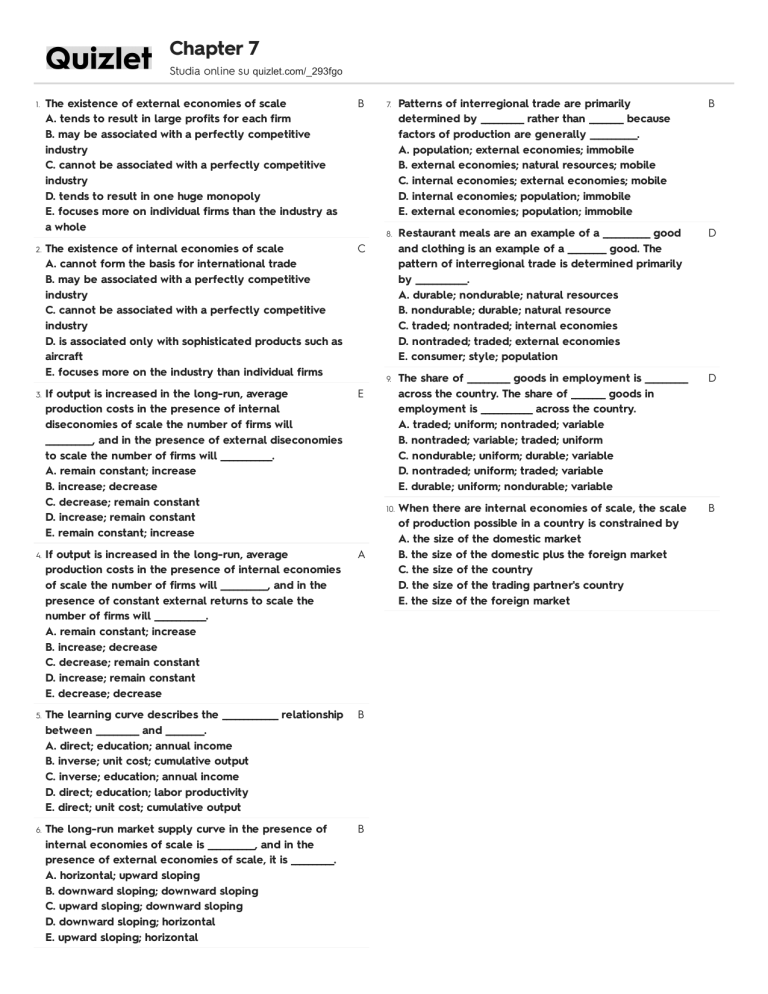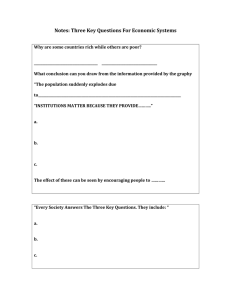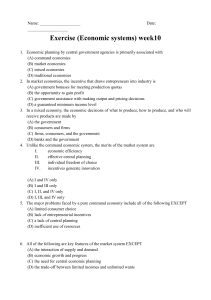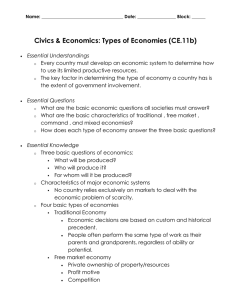
Chapter 7 Studia online su quizlet.com/_293fgo 1. The existence of external economies of scale A. tends to result in large profits for each firm B. may be associated with a perfectly competitive industry C. cannot be associated with a perfectly competitive industry D. tends to result in one huge monopoly E. focuses more on individual firms than the industry as a whole B 2. The existence of internal economies of scale A. cannot form the basis for international trade B. may be associated with a perfectly competitive industry C. cannot be associated with a perfectly competitive industry D. is associated only with sophisticated products such as aircraft E. focuses more on the industry than individual firms C 3. If output is increased in the long-run, average production costs in the presence of internal diseconomies of scale the number of firms will ___________, and in the presence of external diseconomies to scale the number of firms will ____________. A. remain constant; increase B. increase; decrease C. decrease; remain constant D. increase; remain constant E. remain constant; increase E 4. If output is increased in the long-run, average production costs in the presence of internal economies of scale the number of firms will ___________, and in the presence of constant external returns to scale the number of firms will ____________. A. remain constant; increase B. increase; decrease C. decrease; remain constant D. increase; remain constant E. decrease; decrease A 5. The learning curve describes the _____________ relationship between __________ and _________. A. direct; education; annual income B. inverse; unit cost; cumulative output C. inverse; education; annual income D. direct; education; labor productivity E. direct; unit cost; cumulative output B 6. The long-run market supply curve in the presence of internal economies of scale is ___________, and in the presence of external economies of scale, it is __________. A. horizontal; upward sloping B. downward sloping; downward sloping C. upward sloping; downward sloping D. downward sloping; horizontal E. upward sloping; horizontal B 7. Patterns of interregional trade are primarily determined by __________ rather than ________ because factors of production are generally ___________. A. population; external economies; immobile B. external economies; natural resources; mobile C. internal economies; external economies; mobile D. internal economies; population; immobile E. external economies; population; immobile B 8. Restaurant meals are an example of a ___________ good and clothing is an example of a _________ good. The pattern of interregional trade is determined primarily by ____________. A. durable; nondurable; natural resources B. nondurable; durable; natural resource C. traded; nontraded; internal economies D. nontraded; traded; external economies E. consumer; style; population D 9. The share of __________ goods in employment is __________ across the country. The share of ________ goods in employment is ____________ across the country. A. traded; uniform; nontraded; variable B. nontraded; variable; traded; uniform C. nondurable; uniform; durable; variable D. nontraded; uniform; traded; variable E. durable; uniform; nondurable; variable D 10. When there are internal economies of scale, the scale of production possible in a country is constrained by A. the size of the domestic market B. the size of the domestic plus the foreign market C. the size of the country D. the size of the trading partner's country E. the size of the foreign market B



